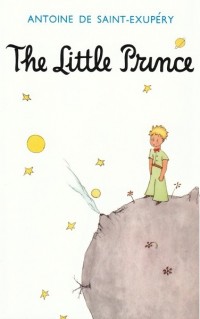A gleam of light in the impenetrable mystery
 The Little Prince
The Little Prince
by Antoine de Saint-Exupéry
translated from French by Katherine Woods
This is my first read for Classics Club and it may have been an odd place to start, or maybe a very good place. I’m not sure. It certainly wasn’t the book I expected and yet, thinking about it, I really should have known exactly how it would be.
First of all, it’s a children’s book, which I knew, but so many adults rave about it that I suppose I thought it wouldn’t read quite so very much like one. Also, it was written in the 1940s and has the moralising tone to suit, though it’s an unusual set of morals that it’s selling.
The story is wonderful, by which I mean both that it’s lovely and that it’s full of wonder. A young pilot crashes his plane in the Sahara Desert and there meets and befriends an alien who has travelled to many worlds. The alien, the little prince of the title, tells the pilot about his home world and his travels and the life lessons he has learned.
The story is certainly magical and charming, but told sparsely without much description. The author’s illustrations scattered through the text are also rather lovely and I liked the slightly surreal humour with which the narrator refers to “his” drawings.
“The little prince broke into a lovely peal of laughter, which irritated me very much. I like my misfortunes to be taken seriously.
Then he added: ‘So you, too, come from the sky! Which is your planet?’
At that moment I caught a gleam of light in the impenetrable mystery of his presence; and I demanded, abruptly: ‘Do you come from another planet?’
But he did not reply. He tossed his head gently, without taking his eyes from my plane: ‘It is true that you can’t have come from very far away.’ “
The theme of friendship is handled beautifully. Without wishing to ruin the story for anyone who has yet to read it, I’ll just say that there is a rose and there is a fox and they both teach the Little Prince lessons about friendship that are surprisingly real, considering the way they’re delivered.
The other major theme is imagination, which is a worthy and fruitful theme, though Saint-Exupéry does take a slightly unusual view on it, which is that grown-ups have no imagination and are very tiresome and difficult for doing such things as going to work or following rules. I know it makes me sound seriously old and boring to take issue with this, and I have nothing against extolling the wonders of imagination, but I do think it is reductive and dangerous to pit children and adults against each other. Honestly, though, I don’t know why this bothered me, because children’s books do it all the time. Roald Dahl certainly did, and plenty of others before him, so what is it about Saint-Exupéry’s version that got to me?
I think perhaps it’s not the theme of imagination itself, it’s the way the Little Prince is ultimately hypocritical, because he is teaching the importance of thinking creatively and differently through a series of lessons that leave no doubt that his is the one correct answer.
“Children should always show great forbearance toward grown-up people. But certainly, for us who understand life, figures are a matter of indifference…If I try to describe him here, it is to make sure that I shall not forget him. To forget a friend is sad. Not everyone has had a friend. And if I forget him I may become like the grown-ups who are no longer interested in anything but figures.”
But it feels wrong to write at all negatively about such a pleasingly strange, happy-sad tale as this. It depicts the small pleasures of life such as sunsets and laughter, as well as one of if not the greatest pleasure – finding a kindred spirit, someone who truly sees the world in the same way you do, or at least who instantly understands your way of seeing the world and can in return show you their own compatible view.
And that’s really quite wonderful.
First published in English and French in 1943.
Source: Christmas present from my sister.
Challenges: This counts towards the Classics Club.
I just read this one recently for Classics Club, too. Even though it’s short and not too hard to read, it isn’t simplistic. I’m glad you mentioned the charming illustrations — they really make the book, don’t they?